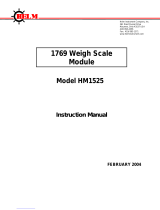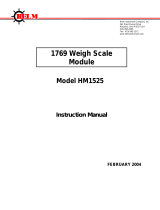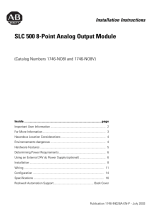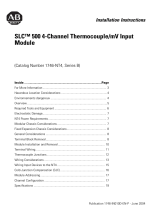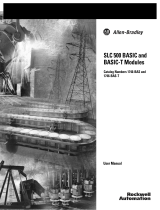
Publication 1746-UM001A-US-P
Table of Contents ii
Input Devices . . . . . . . . . . . . . . . . . . . . . . . . . . . . . . . . . . 3-13
Transducer Source Impedance . . . . . . . . . . . . . . . . . . . 3-13
Wiring Input Devices to the 1746-NI16 . . . . . . . . . . . . . 3-13
Chapter 4
Preliminary Operating
Considerations
Module ID Code . . . . . . . . . . . . . . . . . . . . . . . . . . . . . . . . 4-1
Class 1 and Class 3 Interface . . . . . . . . . . . . . . . . . . . . . . . 4-2
Module Addressing . . . . . . . . . . . . . . . . . . . . . . . . . . . . . . 4-3
Class 1 Memory Map . . . . . . . . . . . . . . . . . . . . . . . . . . 4-3
Class 3 Memory Map . . . . . . . . . . . . . . . . . . . . . . . . . . 4-4
Output Image - Configuration Words . . . . . . . . . . . . . . 4-5
Input Image - Data Words and Status Words. . . . . . . . . 4-5
Module Update Time . . . . . . . . . . . . . . . . . . . . . . . . . . . . 4-6
Channel Filter Frequency Selection . . . . . . . . . . . . . . . . . . 4-9
Channel Frequency . . . . . . . . . . . . . . . . . . . . . . . . . . . 4-9
Response to Slot Disabling . . . . . . . . . . . . . . . . . . . . . . . . 4-11
Input Response . . . . . . . . . . . . . . . . . . . . . . . . . . . . . . 4-11
Output Response . . . . . . . . . . . . . . . . . . . . . . . . . . . . . 4-11
Chapter 5
Channel Configuration, Data, and
Status
Channel Configuration . . . . . . . . . . . . . . . . . . . . . . . . . . . 5-1
Output Image Channel Configuration Procedure . . . . . . . . 5-2
Channel Configuration Word . . . . . . . . . . . . . . . . . . . . 5-3
Select Channel Enable (Bit 15) . . . . . . . . . . . . . . . . . . . 5-4
Select Channel Filter Frequency (Bits 14 through 12). . . 5-4
Select Calibration Mode (Bits 11 through 9) . . . . . . . . . 5-5
Select Data Format (Bits 8 through 6) . . . . . . . . . . . . . . 5-6
Select Input Type (Bits 5 and 4) . . . . . . . . . . . . . . . . . . 5-6
Unused Bit (Bit 3) . . . . . . . . . . . . . . . . . . . . . . . . . . . . 5-6
Class 1 Handshaking (Bit 2) . . . . . . . . . . . . . . . . . . . . . 5-7
Class 1 Data or Status Configuration (Bits 1 and 0) . . . . 5-7
Input Image - Channel Data Word . . . . . . . . . . . . . . . . . . . 5-8
Scaling the Channel Data Word . . . . . . . . . . . . . . . . . . . . . 5-10
Data Type Descriptions . . . . . . . . . . . . . . . . . . . . . . . . 5-10
Scaling Examples . . . . . . . . . . . . . . . . . . . . . . . . . . . . . 5-12
Engineering Units to Real Units . . . . . . . . . . . . . . . . . . 5-13
Scaled-for-PID to Real Units . . . . . . . . . . . . . . . . . . . . . 5-14
Proportional Counts to Real Units. . . . . . . . . . . . . . . . . 5-14
1746-NI4 Data Format Units to Real Units . . . . . . . . . . . 5-15
User-Defined Scaling Data Format to Real Units . . . . . . 5-15
Channel Status Checking . . . . . . . . . . . . . . . . . . . . . . . . . . 5-16
Class 1 Status Word. . . . . . . . . . . . . . . . . . . . . . . . . . . . . . 5-18
Class 3 Status Word. . . . . . . . . . . . . . . . . . . . . . . . . . . . . . 5-19
Input Word Bit Definitions . . . . . . . . . . . . . . . . . . . . . . . . 5-20
Error Conditions (Bits 15 through 13) . . . . . . . . . . . . . . 5-20




















